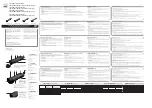
44
Looking at or near the
Sun
will cause
irreversable
damage to your eye. Do not point this telescope at or near the
Sun. Do not look through the telescope as it is moving.
#62 T-Adapter:
The T-Adapter (
Fig. 22
) is the basic means of prime-focus photography through
all Meade Schmidt-Cassegrain models. Thread the T-Adapter on to the rear cell of your
telescope, followed by a T-Mount for your 35mm camera, and the camera body is rigidly
coupled to the telescope.
Variable Tele-Extender:
For eyepiece-projection photography of the Moon and the planets, a
Tele-Extender is required. The variable Tele-Extender threads onto the telescope's eyepiece-
holder, into which is inserted an eyepiece of typically about 26mm focal length; the 35mm
camera body couples to the tele-extender by means of a T-Mount. The Meade Variable
Tele-Extender permits a range of projection images.
Off-Axis Guider:
The Off-Axis Guider (
Fig. 23
) provides a means during long-exposure
astrophotography for the photographer to monitor the tracking of the telescope to assure that
the telescope remains precisely positioned on the object being photographed. Like the
T-Adapter, the Off-Axis Guider couples the camera body to the telescope but it also causes a
small amount of the guidestar’s incoming light to be diverted at a right angle, where the star’s
position can be examined for tracking errors with an illuminated reticle eyepiece; position
corrections can then be effected using AutoStar.
Electric Focusers:
Meade electric focusers are uniquely designed to yield smooth, precise
microfocusing of the image, without disabling the manual focus knob, which may be used for
rapid coarse focusing. Two focuser models are available: the #1205, which includes pushbut-
ton hand controller with self-contained (user-provided) battery, and the #1206, which plugs
directly into the Accessory Port Module (see previous page), with actuation from the hand
controller.
Piggyback Brackets:
Piggyback photography is one of the most popular and easiest ways to
get started in astrophotography. Attach your 35mm camera, with its own 35mm-to-250mm lens,
atop your LX90 in equatorial mode, and guiding the camera through the main telescope, wide-
field photos of the Milky Way of remarkable detail and clarity can be taken.
Dew Shield:
In moist climates, water particles suspended in the atmosphere may condense on
the front surface of the telescope's correcting plate. This dew formation may be inhibited to a
significant extent by the addition of a dew shield, essentially an extension tube attaching to the
front-cell of the telescope.
#541 AC Adapter:
The optional #541 AC Adapter permits powering of the telescope via a
standard household (115v.AC) electrical outlet. Includes the #607 Power Cord (see below).
#607 Power Cord:
Powering the LX90 telescope by means of an automobile cigarette lighter
plug requires the #607 Power Cord. With this 25 ft. cord, the LX90 may be powered for a full
night’s observing without risk of car-battery drain.
Deep Sky Imager Series:
This high-performance, easy-to-use and affordable color CCD cam-
era (
Fig. 24
) suppresses electronic noise and does not compress data from the sensor to
increase picture quality. The Deep Sky Imager uses a full 16-bit analog-to-digital converter to
enhance picture depth, contrast and dynamic range. It is USB compatible for easy interface
with most Windows-based laptop computers. Includes AutoStar Suite which automatically
sorts, aligns and combines the best images, resulting in a highly detailed color image.
The following Deep Sky Imagers models and accessories are available:
Deep Sky Imager II (DSI II) w/Autostar Suite
Deep Sky Imager Pro II (DSI PRO II), w/Autostar Suite
Deep Sky Imager Pro II (DSI PRO II), w/RGB Color Filter Set & Autostar Suite
Deep Sky Imager (DSI) w/Autostar Suite
Deep Sky Imager PRO (DSI PRO), w/Autostar Suite
Deep Sky Imager PRO (DSI PRO), w/RGB Color Filter Set & Autostar Suite
Lunar Planetary Imager (LPI™) w/Autostar Suite
Deep Sky Imager Fan Accessory, for all DSI cameras
Deep Sky Imager RGB Color Filter Set, for DSI PRO and DSI PRO II
Fig. 22: #62 T-Adapter.
Fig. 23: Off-Axis Guider.
Fig. 24:
Meade Deep Sky
Imager









































